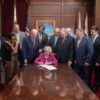Sam Mattison
Alabama Political Reporter
Alabama drivers spent $4.2 billion in unnecessary costs due to poor road quality according to a new report.
The report was compiled by TRIP, a non-profit research organization, in February 2017. They classify these costs as vehicle operating costs, congestion-related costs and traffic accidents. TRIP attributed these costs to the “deficient roads” in Alabama.
It also said that 19 percent of major urban roads in Alabama are in poor condition and 41 percent are in fair to mediocre condition.
The report defines poor roads as roads that “show signs of deterioration, including rutting, cracks and potholes.”
They say they could be solved by either resurfacing the road or, in some cases, the whole road must be reconstructed.
The Alliance for Alabama’s Infrastructure created a Facebook page for Alabama citizens to report on these poor or deficient roads.
“All of the information will be compiled and forwarded to State Senators, State Representatives, the Governor’s office and transportation officials who are tasked with maintaining Alabama’s roadways,” a statement from the organization said.
Most of road funding in Alabama is done by gas taxes. These taxes have not increased on a federal level since 1993 and they haven’t increased in Alabama since 1992.
In 2004, Alabama pulled in $583 million in revenue from the gas tax. Ten years later Alabama pulled $266 million in revenue according to a research project conducted by the Tax Policy Center.
The main contributing factor responsible for the loss in revenue has been the fuel efficiency increase in new car models. Since 2008, the fuel efficiency of light vehicles has increased by 4 percent according to a report from the US Department of Energy.
The increase market share of hybrids and electric cars has also caused a loss of revenue. A study by Bloomberg estimates that 35 percent of new car sales globally will be electric by 2040.
It is also speculated that rising gas taxes might actually push more people to zero-emission cars. According to an article in The Economist, 95 percent of economist in the United States believe gas taxes incentivize people towards zero-admission cars.
Another factor is that gas sales are not the same as before the 2008 financial crash.
The amount of gas bought from retailers daily in December 2016 was only half of what it was in December 2008 according to a report from the US Energy Information Administration. This means that gas tax revenues, on both a state and federal level, were effectively cut in half in 8 years.
There have been attempts to raise the gas tax through State legislation in the past but none of the bills passed into law.
During his campaign, President Donald Trump made a promise to fix America’s infrastructure problem. In 2017, Democrats in the US Senate proposed a $1 trillion infrastructure plan. The White House has yet to respond to the plan.
The report also said that 8 percent of bridges in Alabama are “structurally deficient.” This means that at least one major component of the bridge is significantly damaged.

















































